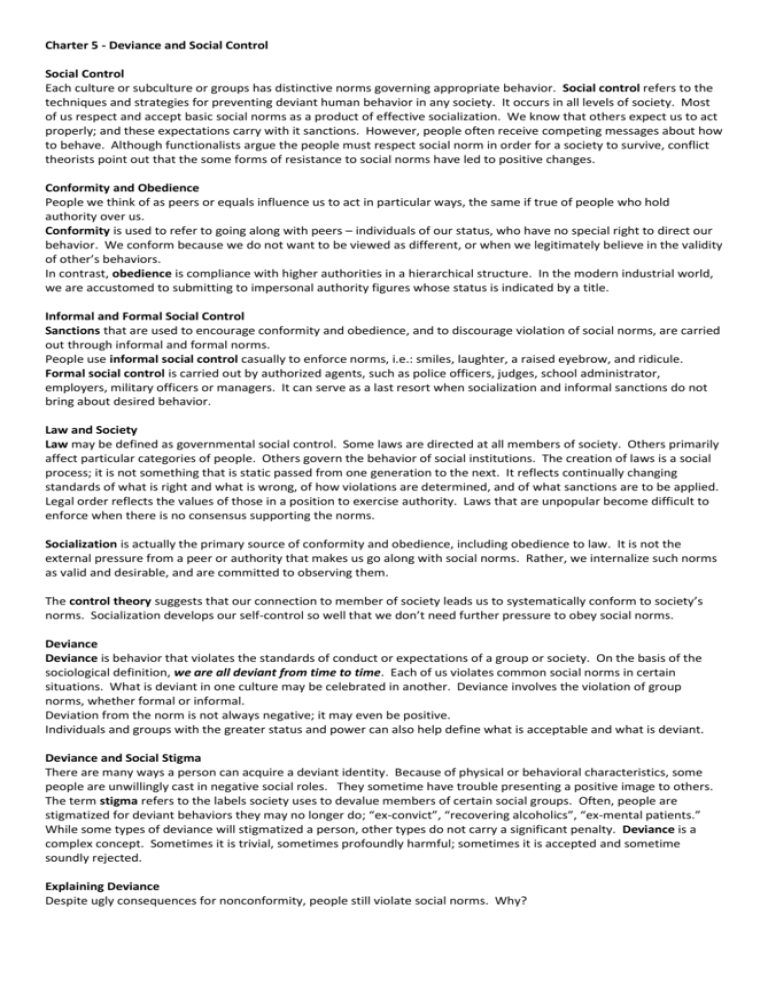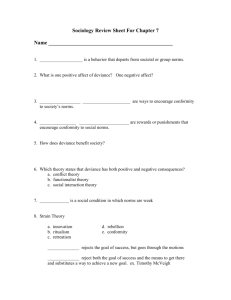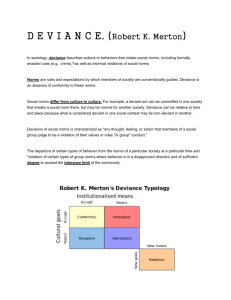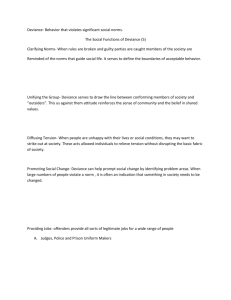Charter 5 - Deviance and Social Control Social Control Each culture
advertisement

Charter 5 - Deviance and Social Control Social Control Each culture or subculture or groups has distinctive norms governing appropriate behavior. Social control refers to the techniques and strategies for preventing deviant human behavior in any society. It occurs in all levels of society. Most of us respect and accept basic social norms as a product of effective socialization. We know that others expect us to act properly; and these expectations carry with it sanctions. However, people often receive competing messages about how to behave. Although functionalists argue the people must respect social norm in order for a society to survive, conflict theorists point out that the some forms of resistance to social norms have led to positive changes. Conformity and Obedience People we think of as peers or equals influence us to act in particular ways, the same if true of people who hold authority over us. Conformity is used to refer to going along with peers – individuals of our status, who have no special right to direct our behavior. We conform because we do not want to be viewed as different, or when we legitimately believe in the validity of other’s behaviors. In contrast, obedience is compliance with higher authorities in a hierarchical structure. In the modern industrial world, we are accustomed to submitting to impersonal authority figures whose status is indicated by a title. Informal and Formal Social Control Sanctions that are used to encourage conformity and obedience, and to discourage violation of social norms, are carried out through informal and formal norms. People use informal social control casually to enforce norms, i.e.: smiles, laughter, a raised eyebrow, and ridicule. Formal social control is carried out by authorized agents, such as police officers, judges, school administrator, employers, military officers or managers. It can serve as a last resort when socialization and informal sanctions do not bring about desired behavior. Law and Society Law may be defined as governmental social control. Some laws are directed at all members of society. Others primarily affect particular categories of people. Others govern the behavior of social institutions. The creation of laws is a social process; it is not something that is static passed from one generation to the next. It reflects continually changing standards of what is right and what is wrong, of how violations are determined, and of what sanctions are to be applied. Legal order reflects the values of those in a position to exercise authority. Laws that are unpopular become difficult to enforce when there is no consensus supporting the norms. Socialization is actually the primary source of conformity and obedience, including obedience to law. It is not the external pressure from a peer or authority that makes us go along with social norms. Rather, we internalize such norms as valid and desirable, and are committed to observing them. The control theory suggests that our connection to member of society leads us to systematically conform to society’s norms. Socialization develops our self-control so well that we don’t need further pressure to obey social norms. Deviance Deviance is behavior that violates the standards of conduct or expectations of a group or society. On the basis of the sociological definition, we are all deviant from time to time. Each of us violates common social norms in certain situations. What is deviant in one culture may be celebrated in another. Deviance involves the violation of group norms, whether formal or informal. Deviation from the norm is not always negative; it may even be positive. Individuals and groups with the greater status and power can also help define what is acceptable and what is deviant. Deviance and Social Stigma There are many ways a person can acquire a deviant identity. Because of physical or behavioral characteristics, some people are unwillingly cast in negative social roles. They sometime have trouble presenting a positive image to others. The term stigma refers to the labels society uses to devalue members of certain social groups. Often, people are stigmatized for deviant behaviors they may no longer do; “ex-convict”, “recovering alcoholics”, “ex-mental patients.” While some types of deviance will stigmatized a person, other types do not carry a significant penalty. Deviance is a complex concept. Sometimes it is trivial, sometimes profoundly harmful; sometimes it is accepted and sometime soundly rejected. Explaining Deviance Despite ugly consequences for nonconformity, people still violate social norms. Why? Functionalist Perspective Deviance is a common part of human existence, with positive as well as negative consequences for social stability. Deviance helps define the limits of proper behavior. According to Durkheim, the formal and informal punishments established within a culture help define an acceptable behavior and thus contribute to stability. He coined the term anomie to refer to the loss of direction felt in a society when social control of individual behavior has become has become ineffective; a state of normlessness that typically occurs during periods of profound social change and disorder. Merton’s Theory of Deviance Merton maintained that a given culture has important cultural goal, such as success that is measure in terms of money. A society also offers specific instructions on how to pursue this goal. People adapt in certain ways, either by conforming or by deviating from such cultural expectations. He viewed that there should be consensus regarding accepted cultural goals and the legitimate means for attaining them. Without such, societies could exist only as collectives of people rather than as unified cultures, and might experience continual chaos Mode Nondeviant Conformity Deviant Innovation Ritualism Retreatism Rebellion Merton’s Anomie Theory of Deviance Modes of Adaptation Institutionalized means (Hard work) Societal Goal (Acquisition of wealth) Accept Accept Reject Accept Reject Replace with new means Accept Reject Reject Replace with new goals The innovator accepts the goals of society but pursues them with means that are regarded as improper. The ritualist has abandoned the goal of material success and become compulsively committed to the institutional means. Work becomes simply a way of life rather than a means to the goal of success. The retreatist has basically withdrawn from both the goals and the means of a society. The rebel feels alienated from dominant means and goals, and may seek a dramatically different social order. The theory helps us to understand deviance as a socially created behavior rather than as the result of momentary pathological impulses. Interactionist Perspective The emphasis on everyday behavior it he focus of the intercationist perspective. It offers two explanations to crime. Cultural Transmission According to Edwin Sutherland, an individual undergoes the same basic socialization process in learning conforming and deviant acts. One learns criminal behavior by interacting with others. Criminal behaviors include techniques of law breaking, as well as the motives, drives, and rationalizations of the criminal. It can also explain the habitual use of alcohol or drugs. Differential association refers to the process through which exposure to attitudes favorable to criminal acts leads to the violation of rules. The extent a person will engage in an activity that is regarded as proper or improper depend on the frequency, duration, and importance of two types of social interaction – those experiences that endorse deviant behavior and those that promote acceptance of social norms. Routine Activities Theory Routine activities theory contends that criminal victimization increases when motivated offenders and suitable targets converge. Car theft is most likely to happen in a location where there are a lot of beautiful cars left in isolation for long periods of time. It stresses the fact that elements of a criminal or deviant act come together in normal, legal, and routine activities. Labeling Theory This theory does not explain why some individual commit deviant acts. Instead, it tackles about why certain people are viewed as deviants and criminals. This theory is also called the social-reaction theory, reminding us that it is the response to an act, and not the act itself, that determines deviance. The labeling theory focuses of the behaviors of regulators of social control, and not those who violate social norms. Some individuals or groups have power to define the label and apply them to others. Conflict Theory Conflict theorists point out that people with power protect their own interests and define deviance to suit their own needs. Crime is a definition of conduct created by authorized agents of social control, such as legislator and law enforcers in a politically organized society. Lawmaking is often an attempt by the powerful to coerce others into their own morality. Feminist Perspective Many of the existing approaches to deviance and crime were developed only with men in mind. For many years, marital rape and wife battering were not viewed as serious crimes. Crime Crime is a violation of criminal law for which government authority applies formal penalties. It represents a deviation from formal social norms administered by the state. Types of Crime Sociologists classify crimes in terms to how they are committed and how society views the offenses. Professional Crime A professional criminal is a person who pursues crimes as a day-to-day occupation, developing skilled techniques and enjoying a certain degree of status among other criminals. They may have specializations. They may acquire skills that reduce the likelihood of arrest, conviction and imprisonment. Organized Crime The work of a group that regulates relations among criminal enterprises involved in illegal activities. They may be as large as corporations. It allocates territory, set prices for goods and services, and acts as an arbitrator in internal disputes. It generally evades law enforcement because conspirational activity. White-Collar and Technology Based Crime White-collar crimes refer to illegal acts committed in the course of business activities, often by affluent, “respectable” people. It includes tax evasion, stock manipulation, consumer fraud, bribery and extraction of kickbacks, and misrepresentation in advertising. Computer crimes refer to the use of high technology that allows criminals carry out embezzlement and electronic fraud. Victimless Crimes Willing exchange among adults of widely desired, but illegal, goods and services, such as prostitution. However, some people reject the notion that there are no victims other than the offender in such crimes.






